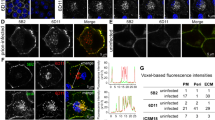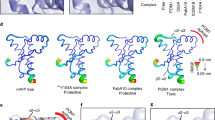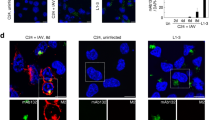Abstract
Prions, the etiological agents for infectious degenerative encephalopathies, act by entering the cell and inducing conformational changes in PrPc (a normal cell membrane sialoglycoprotein), which result in cell death. A specific cell-surface receptor to mediate PrPc and prion endocytosis has been predicted. Complementary hydropathy let us generate a hypothetical peptide mimicking the receptor binding site. Antibodies raised against this peptide stain the surface of mouse neurons and recognize a 66-kDa membrane protein that binds PrPc both in vitro and in vivo. Furthermore, both the complementary prion peptide and antiserum against it inhibit the toxicity of a prion-derived peptide toward neuronal cells in culture. Such reagents might therefore have therapeutic applications.
This is a preview of subscription content, access via your institution
Access options
Subscribe to this journal
Receive 12 print issues and online access
$209.00 per year
only $17.42 per issue
Buy this article
- Purchase on SpringerLink
- Instant access to full article PDF
Prices may be subject to local taxes which are calculated during checkout
Similar content being viewed by others
References
Prusiner, S.B. Genetic and infections prion diseases. Arch. Neurol. 50, 1129–1153 (1993).
Prusiner, S.B. Molecular biology of prion diseases. Science 252, 1515–1522 (1991).
Weissman, C. Molecular biology of prion diseases. Trends Cell Biol. 4, 10–14 (1994).
Baster, K. et al. Scrapie and cellular PrP isoforms are encoded by the same chromosomal gene. Cell 46, 417–428 (1986).
Pan, K.-M. et al. Conversion of alpha-helices into beta-sheets features in the formation of the scrapie prion proteins. Proc. Natl. Acad. Sci. USA 90, 10962–10966 (1993).
Borchelt, D.R., Taraboulos, A. & Prusiner, S.B. Evidence for synthesis of scrapie prion proteins in endocytic pathway. J. Biol. Chem. 267, 16188–16199 (1992).
Büeler, H. et al. Mice devoid of PrP are resistant to scrapie. Cell 73, 1339–1347 (1993).
Shyng, S.-L., Heuser, J.E. & Harris, D.A. A glycolipid-anchored prion proteins endo cytosed via clathrin-coated pits. J. Cell Biol. 125, 1239–1250 (1994).
Vey, M. et al. Subcellular colocalization of the cellular and scrapie priori proteins in caveolae-like membranous domains. Proc. Natl. Acad. Sci. USA 93, 14945–14949 (1996).
Yehiely, F. et al. Identification of candidate proteins binding to prion protein. Neurobiol. Dis. 3, 339–355 (1997).
Forloni, G. et al. Neurotoxicity of a prion protein fragment. Nature 362, 543–546 (1993).
Shyng, S.-L., Moulder, K.J., Laesko, A. & Harris, D.A. The N-terminal domain of a glycolipid-anchored prion protein is essential for its endocytosis via clathrin-coated pits. J. Biol. Chem. 270, 14793–14800 (1995).
Gabriel, J.-M., Oesch, B., Kretzschmar, H., Scott, M. & Prusiner, S.B. Molecular cloning of a candidate for chicken prion protein. Proc. Natl. Acad. Sci USA 89, 9097–9101 (1992).
Brentani, R.R. Biological implications of complementary hydropathy of amino acids. J. Theor. Biol. 135, 495–499 (1988).
Brentani, R.R. Complementary hydropathy and the evolution of interacting polypeptides. J. Mol. Evol. 31, 239–243 (1990).
Baranyi, L. et al. The antisense homology box: A new motif within proteins that encodes biologically active peptides. Nature Med. 1, 894–901 (1995).
Pasqualini, R., Chamone, D.F. & Brentani, R.R. Determination of the putative binding site for fibronectin on platelet glycoprotein llb-llla complex through a hydropathic complementary. J. Biol. Chem. 264, 14566–14570 (1989).
Brentani, R.R. et al. Characterization of the cellular receptor for fibronectin through a hydropathic complementary approach. Proc. Natl. Acad. Sci USA 85, 364–367 (1988).
Souza, S.J. & Brentani, R.R. Collagen binding site in collagenase can be determined using the concept of sense-antisense peptide interactions. J. Biol. Chem. 267, 13763–13767 (1992).
Serban, D., Taraboulos, A., DeArmond, S.J. & Prusiner, S.B. Rapid detection of Creutzfeld-Jacob disease and scrapie prion proteins. Neurology 40, 110–177 (1990).
Goldgaber, D. Anticipating an anti-prion protein. Nature 351, 106 (1991).
Harris, D.A. et al. Processing of a cellular prion protein: Identification of N and C-terminal cleavage sites. Biochemistry 32, 1009–1016 (1993).
Oesch, B. Characterization of the PrP binding proteins. Phil. Tram. R. Soc. Land. B. 343, 443–445 (1994).
Gasset, M. et al. Predicted alpha-helical regions of the prion protein when synthesized as peptides form amyloid. Proc. Natl. Acad. Sci USA 89, 10940–10944 (1992).
Askanas, V., Bilak, M., Engel, W.K., Leclec, A. & Tome, F. Prion protein is strongly immunolocalized at the postsynaptic domain of the human neuromuscular junctions. Neurosci Lett. 159 (1–2), 111–114 (1993).
Shyng, S.-L., Lehmann, S., Moulder, K.L. & Harris, D.A. Sulfated glycans stimulate endocytosis of the cellular isoform of the prion protein, PrPc, in cultured cells. J. Biol. Chem. 270, 30221–30229 (1995).
Moura Neto, V., Mallat, M., Jeantet, C. & Prochiantz, A. Microheterogenity of tubulin proteins in neuronal and glial cells from the mouse brain in culture. EMBO J. 2, 1243–1248 (1983).
Garcia-Abreu, J., Moura Neto, V., Carvalho, S.L. & Cavalcante, L.A.J. Regionally specific properties of midbrain glia. I. interactions with midbrain neurons. Neurosci Res. 40, 471–477 (1995).
Halfter, W., Reinhard, E., Liverani, D., Ortman, R. & Monard, D. Immunocytochemical localization of glia-derived nexin, laminin and fibronectin on the surface of extracellular matrix of C6 rat glioma cells. Eur. J. Neurosci. 1, 297–308 (1989).
Arvan, P., Cameron, R.S. & Castle, D. Secretory membranes of the rat parotid gland: Preparation and comparative characterization. Methods Enzymol. 98, 75–87 (1983).
Smith, D.B. & Johnson, K.S. Single-step purification of polypeptides expressed in Escherichia coli as fusion with glutathione S-transferase. Gene 67, 31–40 (1988).
Weiss, S. et al. Overexpression of active Syrian golden hamster prion protein PrPc as a glutathione S-transferase fusion in heterologous systems. J. Virol. 69, 4776–4783 (1995).
Author information
Authors and Affiliations
Rights and permissions
About this article
Cite this article
Martins, V., Graner, E., Garcia-Abreu, J. et al. Complementary hydropathy identifies a cellular prion protein receptor. Nat Med 3, 1376–1382 (1997). https://doi.org/10.1038/nm1297-1376
Received:
Accepted:
Issue Date:
DOI: https://doi.org/10.1038/nm1297-1376
This article is cited by
-
Cellular prion protein offers neuroprotection in astrocytes submitted to amyloid β oligomer toxicity
Molecular and Cellular Biochemistry (2023)
-
The Hsp70–Hsp90 go-between Hop/Stip1/Sti1 is a proteostatic switch and may be a drug target in cancer and neurodegeneration
Cellular and Molecular Life Sciences (2021)
-
The function of the cellular prion protein in health and disease
Acta Neuropathologica (2018)
-
The unconventional secretion of stress-inducible protein 1 by a heterogeneous population of extracellular vesicles
Cellular and Molecular Life Sciences (2013)
-
Interactions of Prion Protein With Intracellular Proteins: So Many Partners and no Consequences?
Cellular and Molecular Neurobiology (2010)



